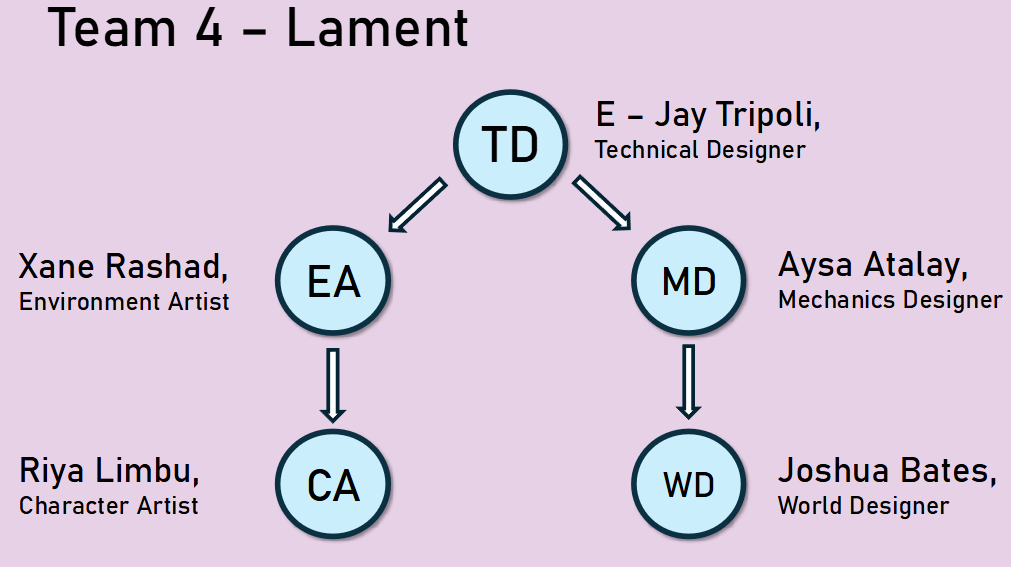A major part of this project is being able to understand and reflect real roles in industry, knowing what my responsibilities are and the responsibilities of real industry professionals with the same role is essential for that.
Technical Designer

When our teams were announced and shown to us, I found out that I was the team’s Technical Designer. In terms of the project overall, Sophie told me that my role was the one who would be communicating with the “higher-ups” the most (Being the course-leaders Vanissa and Sophie). However in terms of the group, it meant that I would be the one who would mostly communicate with everyone – merging different ideas and processes between the design side (Aysa and Josh) and the art side (Xane and Riya).
Technical Designers in Industry
However, in order to this I needed to know what responsibilities and tasks I had to deal with myself. A perfect way to do this was to research what they were for real industry professionals who were Technical Designers.
From researching Technical Designers, I found that their main responsibilities were:
| Industry Responsibility |
|---|
| Translating design into systems |
| Prototyping mechanics |
| Tool and workflow support |
| System scalability |
| Interdisciplinary collaboration |
| Documentation |
How does this translate to my role?
After using academic resources to research the responsibilities of a Technical Designer, it is key to evaluate them and understand how they should apply to me in this project. Furthermore, I will provide links to posts that showcase how I have understood and fulfilled my role:
| Industry Responsibility | Translation to my role |
|---|---|
| Translating design into systems | Taking Lament’s GDD and implementing mechanics in Unity |
| Prototyping mechanics | Testing core mechanics (e.g. movement, combat, Tree of Sorrow) |
| Tool and workflow support | Creating robust systems in Unity for my teammates |
| System scalability | Structuring code for maintainability and reuse across scenes and features |
| Interdisciplinary collaboration | Communicating with my groups designers and artists to ensure everything works well together |
| Documentation | Website developer logs and explaining systems and code that I wrote |
How have I fulfilled these responsibilities?
| Industry Responsibility | What I’ve done |
|---|---|
| Translating design into systems | Developed a Procedural Room Generation System Created a fully-functional Skill Tree Developed various enemy types Developed a Player movement and combat [All of which were heavily influenced by the GDD or with informed decisions from researching existing games] |
| Prototyping mechanics | Constantly tested Player movement and combat feel [Which resulted in an entire redo of the player’s attack] Tested prototypes of the skill tree step-by-step |
| Tool and workflow support | For the Procedural Room Generation, I created arrays of rooms that could spawn in the dungeon in a ‘RoomTemplates’ script, which our level designer could simply drag and drop in new rooms that they had designed. Created animator bools and floats that Xane used to implement enemy animations and player animations |
| System scalability | For the Procedural Room Generation, I created arrays of rooms that could spawn in the dungeon in a ‘RoomTemplates’ script, which could be infinitely scaled with the development of new room prefabs. The Skill Tree uses SkillSO scriptable objects that I used to quickly and efficiently scale the Tree of Sorrow |
| Interdisciplinary collaboration | Explaining to our Mechanics Designer about how animations would translate and be used in Unity When explaining that we should redo the player entirely, I brought up how the old player had 8 attack directions. While we had 4 attack animations |
| Documentation | The Development section of this website documents all of the scripts and systems I made and explains them fully |
Evaluating my performance
As I am writing this as the project comes to an end, It is an essential part of the Learning Outcomes that I am able to evaluate my teamwork role in its professional context:
- Did I adapt to the needs of the team in a way that reflect professional practise?
- Did I take initiative or leadership where needed?
- I was able to make informed decisions about the design of certain aspects of the game and communicate that to my groupmates [Design and functionality of the Tree of Sorrow]
- What skills did I develop that professionals in this role also use?
- I was able to communicate effectively between the design-team and art-team to ensure that both disciplines worked well technically [Explaining to our Mechanics Designer about how animations would translate and be used in Unity, Reducing the number of attacks to lighten work load on our character artist/animator]
Resources used in this research
Hitmarker. (2023). Technical Design Jobs in the Video Game Industry: The Ultimate Quick Guide. [online] Available at: https://hitmarker.net/technical-design-jobs-in-the-video-game-industry-the-ultimate-quick-guide
[Accessed 21 Mar 2025]
DigiPen. (2021). DigiPen Game Design Disciplines, Explained: Technical Design. [online] Available at: https://www.digipen.edu/showcase/news/digipen-game-design-disciplines-explained-technical-design [Accessed 21 Mar 2025].